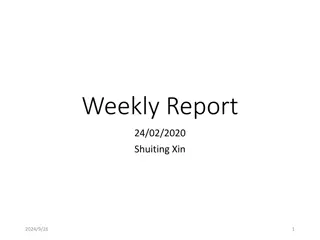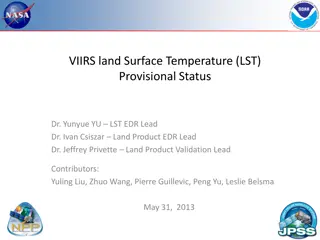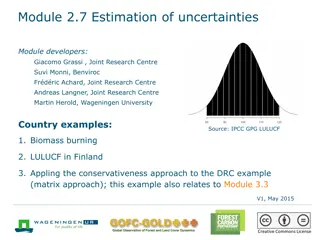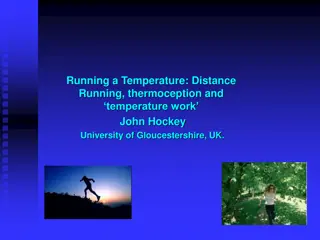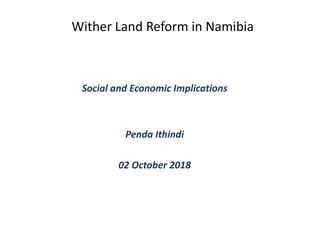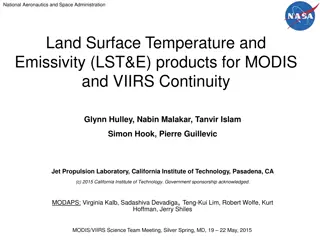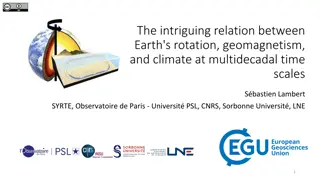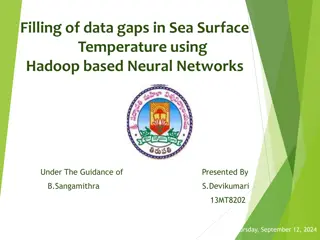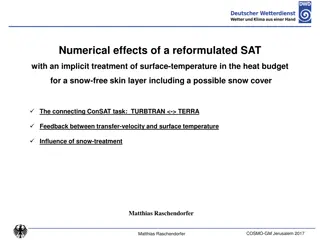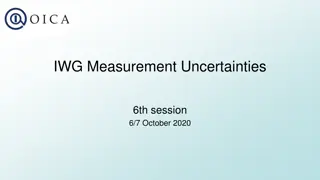Importance of Uncertainties in Land Surface Temperature Data Analysis
Uncertainties play a crucial role for users of Land Surface Temperature (LST) data as they help in understanding the degree of doubt in measured values. Claire Bulgin from the University of Reading emphasizes the difference between error and uncertainty, highlighting the necessity of considering uncertainties in data analysis to make accurate interpretations and conclusions. Utilizing information on uncertainties can enable researchers to explore various research questions related to diurnal cycles in LST data, such as average diurnal cycles across multiple days or climatological patterns over different years.
Download Presentation

Please find below an Image/Link to download the presentation.
The content on the website is provided AS IS for your information and personal use only. It may not be sold, licensed, or shared on other websites without obtaining consent from the author. Download presentation by click this link. If you encounter any issues during the download, it is possible that the publisher has removed the file from their server.
E N D
Presentation Transcript
Why are uncertainties important for users of LST data? Claire Bulgin University of Reading, National Centre for Earth Observation ESA UNCLASSIFIED - For Official Use
Background Every measurement we make (both in-situ or remotely sensed) deviates from the true surface temperature due imperfections in the instrumentation and measurement process. Therefore, in order to use the data correctly, you must consider the uncertainty in the measurement. Error and uncertainty are two different concepts Error: How different is the measured value from the true value? Uncertainty: To what degree is the measured value in doubt? Measurement error is often unknown (and if we did know what it was we would correct for it). We therefore provide an uncertainty, a measure of the dispersion of the error distribution. ESA UNCLASSIFIED - For Official Use ESA | 01/01/2016 | Slide 2
Diurnal cycle in LST (1) Research question: What is the diurnal cycle in LST on a given day over this part of the African continent? 330 K 280 K 0000 2400 1200 ESA UNCLASSIFIED - For Official Use ESA | 01/01/2016 | Slide 3
Diurnal cycle in LST (2) Research question: What is the diurnal cycle in LST on a given day over this part of the African continent? 330 K Tmax Diurnal Range Tmin 280 K 0000 2400 1200 ESA UNCLASSIFIED - For Official Use ESA | 01/01/2016 | Slide 4
Diurnal cycle in LST (3) Research question: What is the diurnal cycle in LST on a given day over this part of the African continent? 330 K 280 K 0000 2400 1200 ESA UNCLASSIFIED - For Official Use ESA | 01/01/2016 | Slide 5
Diurnal cycle in LST (4) Research question: What is the diurnal cycle in LST on a given day over this part of the African continent? 330 K Tmax Diurnal Range Tmin 280 K 0000 2400 1200 ESA UNCLASSIFIED - For Official Use ESA | 01/01/2016 | Slide 6
How do I use this information? The simplest approach: Quantify the uncertainty on Tmax and Tmin using the uncertainties provided with the data. What other research questions might I want to answer having found this result ? Let s consider using data from multiple days: 1) What is the average diurnal cycle from all days in a given month? 2) What is the climatological diurnal cycle for the same day over a number of different years? ESA UNCLASSIFIED - For Official Use ESA | 01/01/2016 | Slide 7
Diurnal cycle in LST (4) 330 K Tmax Diurnal Range Tmin 280 K 0000 2400 1200 ESA UNCLASSIFIED - For Official Use ESA | 01/01/2016 | Slide 8
Uncertainty components (1) Random Surface Atmosphere 1) What is the average diurnal cycle from all days in a given month? Random Surface Atmosphere = = Averaging multiple observations Tmax The same will apply to all timesteps when quantifying the diurnal cycle ESA UNCLASSIFIED - For Official Use ESA | 01/01/2016 | Slide 9
Uncertainty components (2) Random Surface Atmosphere 2) What is the climatological diurnal cycle for the same day over a number of different years? Random Surface or Atmosphere = = Averaging multiple observations For the surface component consider location, time of year and length of data record: greening? Snow cover? Land use change? Tmax ESA UNCLASSIFIED - For Official Use ESA | 01/01/2016 | Slide 10
LST continental average (1) Research question: What is the average LST over the African continent at a given time? Total uncertainty ESA UNCLASSIFIED - For Official Use ESA | 01/01/2016 | Slide 11
Uncertainty components Random Surface Atmosphere What is the average LST over the African continent at a given time? Random Surface Atmosphere = = Averaging multiple observations ESA UNCLASSIFIED - For Official Use ESA | 01/01/2016 | Slide 12
LST continental average (1) Research question: What is the average LST over the African continent at a given time? Total uncertainty Note: for infrared data be aware that cloud cover adds extra uncertainty to spatial averages ESA UNCLASSIFIED - For Official Use ESA | 01/01/2016 | Slide 13
Summary Uncertainties inform users of the degree to which the data are in doubt. Uncertainties are relevant for all applications scientific conclusions drawn from data require an understanding of uncertainty to ensure that they are robust. The upcoming practical will enable you to explore the uncertainty information further and ask the demonstrators how it might be relevant to your application. ESA UNCLASSIFIED - For Official Use ESA | 01/01/2016 | Slide 14


